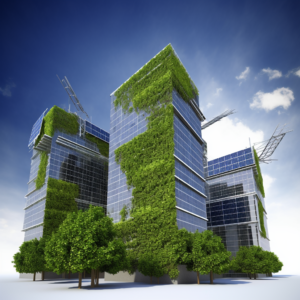Energy-efficient buildings are instrumental in reducing energy consumption, decreasing greenhouse gas emissions, and promoting sustainable practices in the construction industry. By adopting energy-efficient design principles and utilizing advanced technologies, buildings can minimize their environmental impact while creating comfortable and sustainable living and working spaces. Here are key aspects and benefits of energy-efficient buildings:

- Efficient Building Envelope:
- A well-insulated building envelope, including walls, roofs, windows, and doors, helps minimize heat transfer and air leakage. This improves thermal comfort, reduces the need for heating and cooling, and lowers energy consumption.
- High-Performance Windows:
- Energy-efficient windows with low-emissivity (low-E) coatings, multiple glazing layers, and proper sealing reduce heat loss, solar heat gain, and air infiltration. They optimize natural light, maintain indoor comfort, and contribute to overall energy savings.
- Lighting Systems:
- Energy-efficient lighting systems, such as LED (light-emitting diode) bulbs, use significantly less energy than traditional incandescent or fluorescent lighting. Incorporating smart lighting controls, such as occupancy sensors and daylight harvesting, further reduces energy waste.
- Heating, Ventilation, and Air Conditioning (HVAC) Systems:
- Energy-efficient HVAC systems employ advanced technologies like variable-speed compressors, heat pumps, and high-efficiency filters. They provide precise control over indoor temperature, humidity, and air quality while minimizing energy consumption.
- Renewable Energy Integration:
- Incorporating renewable energy sources, such as solar panels or wind turbines, can offset a building’s energy consumption and reduce reliance on fossil fuels. On-site renewable energy generation contributes to lower carbon emissions and long-term energy cost savings.
- Energy Management and Monitoring:
- Implementing energy management systems allows for real-time monitoring, data analysis, and optimization of energy usage. These systems identify energy inefficiencies, provide insights for improvement, and enable informed decision-making to enhance building performance.
- Smart Building Technologies:
- Utilizing smart building technologies, including automated controls, occupancy sensors, and building management systems, optimizes energy use and improves operational efficiency. These technologies ensure energy-consuming systems are activated only when needed, resulting in significant energy savings.
- Water Conservation:
- Energy-efficient buildings often incorporate water-saving fixtures, such as low-flow toilets and faucets, as well as rainwater harvesting systems. These measures reduce water consumption, alleviate pressure on water resources, and contribute to overall sustainability.
Visit The Gardeners Den website if you love things green and the garden!
Benefits of Energy-Efficient Buildings:
- Lower energy consumption and reduced utility costs
- Decreased greenhouse gas emissions and environmental impact
- Enhanced occupant comfort and well-being
- Improved indoor air quality and ventilation
- Increased property value and market competitiveness
- Long-term operational cost savings and financial viability
- Compliance with energy efficiency regulations and certifications
By prioritizing energy-efficient design, construction, and retrofitting practices, we can significantly reduce the carbon footprint of buildings and create more sustainable built environments. Encouraging government incentives, industry standards, and public awareness will accelerate the adoption of energy-efficient buildings, leading to a greener and more resilient future.
As an Amazon Associate we earn from qualifying purchases through some links in our articles.
